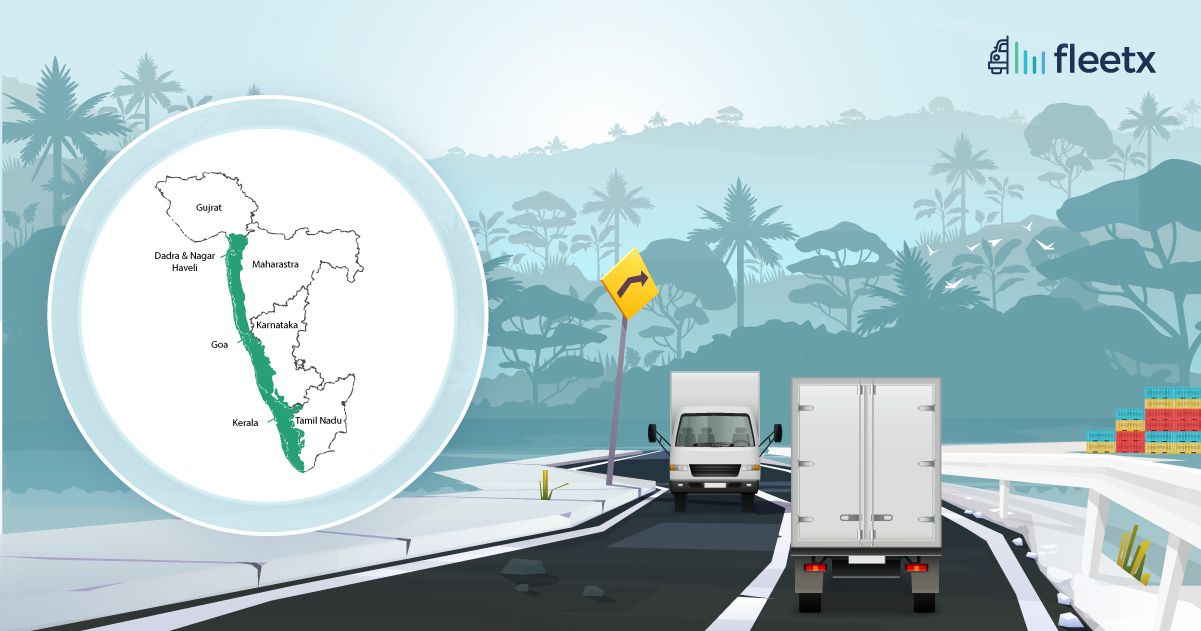
History and Overview of Western Ghats
Western Ghats's geologically diverse and ecologically rich ecosystem contains more than 30% of all flora and fauna in India despite covering just 6% of the Indian sub-continent. The region runs parallel to the western coast of India, spanning the states of Gujarat, Maharashtra, Goa, Karnataka, Kerala and Tamil Nadu, covering an area of 160,000 km square and 1600 km in length. The western ghats are also one of the eight biodiversity hotspots in the world and are recognised as a UNESCO World Heritage Site. The region receives very high rainfall across different parts, particularly western parts. Western ghats also form one of the four watersheds in India, feeding several rivers in India, including Godavari, Kaveri, Krishna, Thamirabarani and Tungabhadra.
Economic Significance of Western Ghats
The western ghats also account for more than 80% of India’s hydropower generation and host more than 50 dams and several artificial lakes and reservoirs.
Ports and Shipping
Shipping is critical to the supply chain, and the western coast of India has several key ports responsible for the movement of large quantities of goods. Kandla Port, Gujarat, Jawaharlal Nehru Port, Navi Mumbai, Kochi Port, Kochi, New Mangalore Port, Mumbai Port, and Mormugao Port are some of the key ports in the Western Ghats. Ports along the western ghats witness a much higher movement of goods than the ports on the eastern ghats. Several new ports are currently being constructed along the western ghats; however, they are at crossroads with the ecosystem.
Tourism
The average climate of the region is tropical and humid. Tourism is of great economic significance to the western ghats, particularly during the monsoon. Several regions within the western ghats are ecologically very sensitive, with many biodiversity hotspots and protected areas.
Mining, quarrying and agricultural land-use
In addition to its rich biodiversity, western ghats are the source of various minerals, metals and other economic resources. Western ghats are rich in iron, manganese and bauxite ores. The forests of the Western Ghats are also an important source of timber and support many forest-produce-based industries. The region also sees the cultivation of several crops, particularly cash crops like pepper, cardamon, tea, coffee, rubber and palm oil.
Overview of the supply chain and Transport connectivity in the Western Ghats
Due to its dynamic geology and presence of several ecologically sensitive zones, transportation and supply chain remains a key challenge in the western ghats. There is no denying that infrastructure development is the need of the hour, and the government needs to take affirmative steps to improve transportation across the regions in the western ghats. However, if infrastructure development comes at the cost of deteriorating the ecosystem, there may be better decisions. Over the years, central and state governments have tried to improve the region's supply chain connectivity and transportation. Several essential national highways which witness a substantial flow of cargo and supply chain pass through the western ghats.
For example, National Highway 66 connects Panvel, Navi Mumbai, to a town in Kanyakumari and passes through Maharashtra, Goa, Karnataka, Kerala and Tamil Nadu. The NH-66 allows for the movement of goods by trucks from different states accessible through the highway to the major sea ports of India. Before Konkan Railway was established in 1998, this highway was the only source of connection between areas in the coastal districts between Mumbai and Bengaluru.
Several roads connecting different places in the states are also referred to as ghat roads. The roads connecting the hill stations across the western ghats to the nearby coastal areas were constructed during the British Raj. Today these roads are essential for the movement of people and goods between coastal and hilly regions within the western ghats. Ghat roads were further renovated and upgraded to serve higher traffic flows throughout the year. Well-maintained ghat roads have been essential to the region's economy as they witness high tourism traffic and are also needed to maintain a constant supply of goods to the region. In 2020, three ghat roads, including Sampaje Ghat, were announced to be strengthened. The development of road infrastructure within the western ghats received a boost after the launch of the Bharatmala Project in 2017.
However, at times, development work to improve road and transportation networks within the eco sensitive regions comes at the cost of destroying the sensitive ecosystem of the western ghats. The widening of NH-4A, which passes through the ghats, cutting across dense forest connecting Belagavi and Goa, received heavy scrutiny from environmentalists and the general public. According to a news report, despite the reservations of forest officials, the project that will affect the districts of Belagavi and Uttara Kannada has been officially approved by both the state and national wildlife boards, purportedly under pressure from the political-industry nexus. Similar opposition has been faced by the government for road infrastructure work for other projects such as the new Mangaluru-Bengaluru highway announced in 2020, India's third longest tunnel road project in Vavul Mala in Kerala, and the highly debated Chikkamangaluru road project, among several others. The Ministry of Environment, Forest and Climate Change (MoEFCC) has granted environment clearances (EC) to 76 projects in the Western Ghats since July 2014, according to an IndiaSpend analysis of proposed projects granted approvals or expedited from July 2014 to March 2020.
The state of supply chain in Western Ghats at state-level
Earlier this year, the central government launched the National Logistics Policy (NLP) to improve the state of logistics nationally. Several state level governments have taken the effort further by adding on to it with their state-level logistics policies. Several states have launched their own action plan on logistics in line with the NLP 2022. One of the front runners is the state of Kerala which is an ecologically sensitive state and includes a substantial portion of western ghats. Kerala sees an influx of inbound logistics as compared to outbound logistics, that too by road. Thus, there is a need to diversify and strengthen the supply chain infrastructure across different modes and promote 3PL providers to offer a wide variety of services within the state. Kerala released a draft Kerala State Logistics Action Plan in 2021 with a vision to develop the logistics sector with multi-modal connectivity and technological integration to make transportation cheaper, efficient and safer. A multi-dimensional analysis of the state's cargo sector was also conducted to prioritise cargo under the action plan.
Overview of Kerala’s logistics action plan
The state action plan puts special emphasis on infrastructure development, particularly transport infrastructure. Moreover, it lays out key initiatives along with implementing agencies and KPIs to track progress as described in the image above.
State-level supply chain challenges faced by business in Kerala
The roads in Kerala do not support large trucks with maximum tonnage permitted across the country. As a result, the cost of transportation becomes more expensive due to more trucks with lower tonnage to deliver cargo within the state. The state also lags behind in availability of essential components such as warehousing and loading docks that are essential to boost multi-modal transportation within the state. Due to the imbalance between import-export within the state the volume of cargo entering the state is exponentially more than the volume existing in the state. As a result, non-availability of return cargo increases the cost of transportation in the state. The state also lacks adequate number of facilities for cold storage and other specialised cargo transportation. Lack of digitalisation and transport management system makes the logistics sector over-reliant on manual intervention. Lack of digitalisation is also one of the key reasons for lack of supply chain visibility and related information like storage availability at warehouses. Due to its vulnerable ecosystem, Kerala is prone to disasters such as landslides and flooding every year which can completely disrupt supply chain operations and damage critical infrastructure.
The struggle between development and conservation in the western ghats
The western ghats are extremely vulnerable, and resource extraction, ill-considered infrastructure projects and increasing tourism are destroying the highly sensitive ecology of the western ghats. The direct impact of destruction is faced by locals experiencing increasing floods and landslides during monsoons destroying crops, houses, and properties. On the one hand, projects like the Hubbali-Ankola Railway Project have great advantages, such as improving the supply chain and bringing down transportation costs which remain relatively higher in India. However, it also comes at the cost of the destruction of 596 hectares of Protected Areas and over 178,000 trees in the vulnerable and dense regions of the western ghats. Such scenarios often make it difficult for policymakers and general citizens to choose between the two, considering the state of project implementation in India. The solution to the conundrum lies in developing creative ways to proceed with infrastructure without harming the ecosystem. Kasturirangan Committee was tasked with developing a holistic approach to sustainable and equitable development and ecological conservation in the Western Ghats. The committee’s report proposed declaring approximately 37% of the western ghats as eco-sensitive areas (ESAs) in addition to other measures, such as a blanket ban on mining & quarrying activities. The Karnataka government had opposed the implementation of the recommendation as close to a third of the total area for ESA falls in Karnataka. The state government also stated that implementing the draft notification will adversely impact local residents and their livelihoods and hinder regional development activities.
Final Thoughts
The International Union for Conservation (IUCN), in its World Heritage Outlook 3 in 2020, expressed concerns over the conservation outlook in the western ghats. The rising impacts of climate change are devastating lives and livelihoods around the world, and things will only change for the worse if action is not taken to prevent it. The Western Ghats are one of the key ecosystems that can help protect us against the adverse impacts of climate change and thus needs protection. While the need for developing infrastructure and transportation networks in the region cannot be neglected, they must be carried out in an ecologically sound manner and consultation with residents and experts. Several examples of infrastructure development without destroying the ecosystem are available from India and around the world. Thus policymakers need to strike a fine balance between development and conservation in the western ghats.






